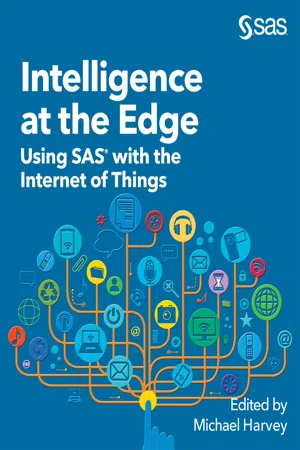
Intelligence at the Edge
Using SAS with the Internet of Things (Hardcover edition)
- 288 pages
- English
- ePUB (mobile friendly)
- Available on iOS & Android
About This Book
Explore powerful SAS analytics and the Internet of Things!
The world that we live in is more connected than ever before. The Internet of Things (IoT) consists of mechanical and electronic devices connected to one another and to software through the internet. Businesses can use the IoT to quickly make intelligent decisions based on massive amounts of data gathered in real time from these connected devices. IoT increases productivity, lowers operating costs, and provides insights into how businesses can serve existing markets and expand into new ones.
Intelligence at the Edge: Using SAS with the Internet of Things is for anyone who wants to learn more about the rapidly changing field of IoT. Current practitioners explain how to apply SAS software and analytics to derive business value from the Internet of Things. The cornerstone of this endeavor is SAS Event Stream Processing, which enables you to process and analyze continuously flowing events in real time. With step-by-step guidance and real-world scenarios, you will learn how to apply analytics to streaming data. Each chapter explores a different aspect of IoT, including the analytics life cycle, monitoring, deployment, geofencing, machine learning, artificial intelligence, condition-based maintenance, computer vision, and edge devices.
Frequently asked questions
Information
Table of contents
- Contents
- Preface
- About the Author
- Chapter 1: Using SAS Event Stream Processing to Process Real World Events
- Chapter 2: Linking Real-World Data to SAS Event Stream Processing Through Connectors and Adapters
- Chapter 3: Applying Analytics to Streaming Data
- Chapter 4: Administering SAS Event Stream Processing Environments with SAS Event Stream Manager
- Chapter 5: SAS Event Stream Processing in an IoT Reference Architecture
- Chapter 6: Artificial Intelligence and the Internet of Things
- Chapter 7: Using Geofences with SAS Event Stream Processing
- Chapter 8: Using Deep Learning with Your IoT Digital Twin
- Chapter 9: Leveraging ESP to Adapt to Variable Data Quality for Location-Based Use Cases
- Chapter 10: Condition Monitoring Using SAS Event Stream Processing
- Chapter 11: Analytics with Computer Vision on the Edge
- Summary